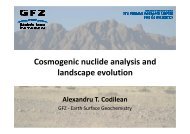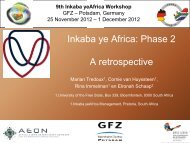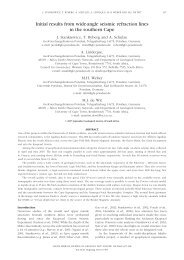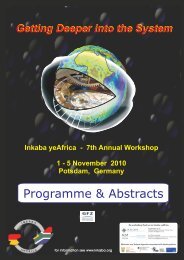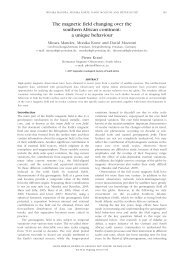South Africa - Inkaba.org
South Africa - Inkaba.org
South Africa - Inkaba.org
You also want an ePaper? Increase the reach of your titles
YUMPU automatically turns print PDFs into web optimized ePapers that Google loves.
Structural features of the Bokkeveld Group (Cape Supergroup)<br />
in the Eastern Cape, <strong>South</strong> <strong>Africa</strong><br />
Gideon Brunsdon 1 , P.W.K. Booth 2 , J.A. Mondon 3<br />
1. NMMU, <strong>South</strong> <strong>Africa</strong>, gideon.brunsdon@nmmu.ac.za<br />
2. NMMU, <strong>South</strong> <strong>Africa</strong>, peter.booth@nmmu.ac.za<br />
3. NMMU, <strong>South</strong> <strong>Africa</strong>, jean-luc.mondon@nmmu.ac.za<br />
ABSTRACT<br />
Previous studies of the Bokkeveld Group focussed mostly on the sedimentation and sedimentary features of this<br />
group with a view to interpreting the depositional environment. This study aims to contribute new information on<br />
the structural features of the Bokkeveld Group north-west of Uitenhage in the Eastern Cape, where there is<br />
evidence of folding and thrust faulting, similar to that occurring in the under- and overlying groups of the Cape<br />
Supergroup.<br />
Field work to date shows that predominantly argillaceous beds of siltstones and mudstones, with lesser arenites and<br />
thin conglomerates make up the Bokkeveld Group. This group conformably overlies the Table Mountain Group of<br />
predominantly arenaceous beds. Both groups have been folded into asymmetric anticlines and synclines, with a<br />
prominent, south-dipping pervasive cleavage developed in the Bokkeveld Group. The fissile nature of argillaceous<br />
beds on outcrop have required that very careful observations of the all important bedding-cleavage relationship in<br />
the field are made, so that correct interpretations of facing direction of strata can be applied. Thrust faults showing<br />
fore-and backthrusts in the Bokkeveld Group are interpreted to have formed during a main deformation phase of<br />
the Cape Orogeny, during the Permian.<br />
Samples of mainly argillaceous rocks have been collected and mineral compositions identified with the aid of a<br />
petrographic microscope and a scanning electron microscope (SEM). Bedding in argillaceous shales of the Gydo<br />
Formation shows a graded texture with layers of coarse grained silicate minerals alternating with fine grained<br />
chlorite. Chlorite, muscovite and quartz make up the major minerals in the shales, and accessories include zircon,<br />
Rare Earths minerals and opaques (iron ore).<br />
In places bedding planes dip predominantly to the northeast, but this is probably a function of poor outcrop because<br />
bedding does dip in the opposite direction elsewhere in the study area, indicating the presence of folding in the<br />
Bokkeveld Group. A pervasive cleavage dips consistently to the southeast, and appears to be thrust fault related. It<br />
is however possible that some of the cleavage development might also be closely related to folding in the<br />
Bokkeveld Group. This relationship needs to be carefully verified through further microscopic studies. The results<br />
of this study will inevitably point to the fact that strata have been disrupted by structures such as folds, thrust faults<br />
and cleavages to the extent that the stratigraphic order of the Bokkeveld Group in this area will have to be reassessed.<br />
KEYWORDS: Bokkeveld Group, cleavage, folded, faulted strata<br />
12



